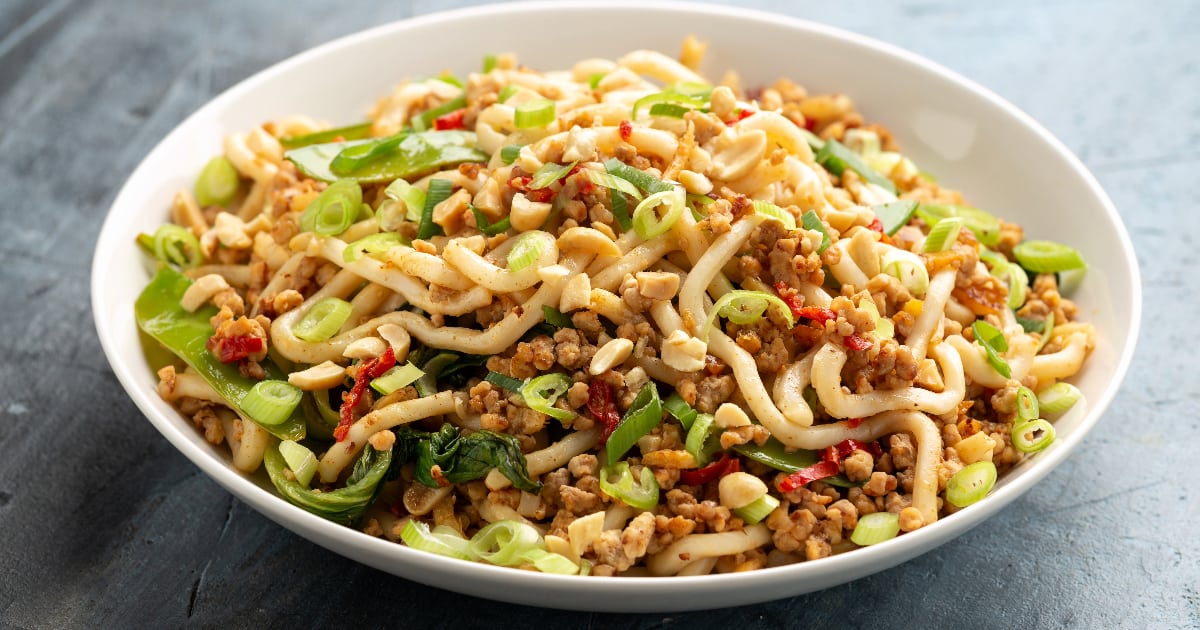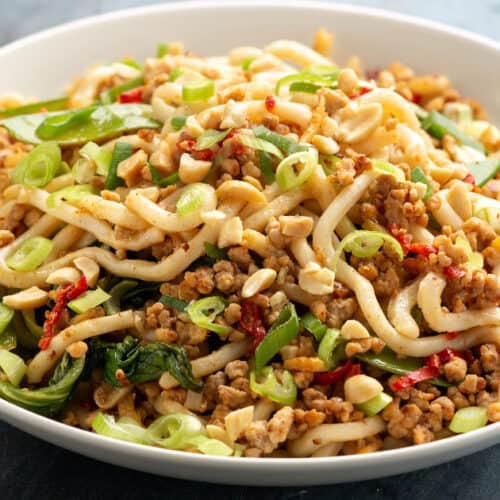Gochujang and peanut butter are a match made in heaven when it comes to creating flavorful noodle dishes.

This Korean-inspired peanut noodle recipe combines the nutty creaminess of peanut butter with the sweet heat of gochujang chili paste for a quick, easy, and delicious weeknight meal.
Make the Gochujang Peanut Sauce
The star of this noodle dish is the gochujang peanut sauce. It starts with gochujang, a fermented Korean chili paste that lends a savory umami flavor along with a kick of heat. Whisk the gochujang together with smooth peanut butter, soy sauce (or tamari for gluten-free), rice vinegar, minced garlic, toasted sesame oil, and a touch of sweeteners like maple syrup or coconut sugar. The peanut butter provides a rich, nutty base while the rice vinegar adds a bright acidity to balance out the other flavors. Warm water helps thin out the sauce to the perfect drizzling consistency.
Taste the peanut sauce as you go, and tweak any flavors to your preferences. Add more gochujang for extra heat, a splash more vinegar to brighten it up, or extra sweetener if you want it a little sweeter. The beauty of this easy homemade sauce is tailoring it to your own tastes.
Cook the Noodles
One of the best parts about peanut noodle recipes is how quick and easy they are to make on busy weeknights. For the noodles, you can use almost any variety you prefer. Chewy udon or soba noodles are classic choices that pair beautifully with the sauce. For gluten-free diners, rice noodles or zucchini noodles make tasty alternatives.
Cook the noodles according to package directions until tender but not mushy. Drain them well and lightly rinse with cool water to remove excess starch, then toss them with a little sesame oil to prevent sticking. This prep work can be done in the time it takes to whisk up the quick peanut sauce.
Put It All Together
Now for the fun part - tossing everything together! Add the hot drained noodles and any sautéed protein or vegetables into the gochujang peanut sauce. Toss and stir the noodles until they are evenly coated in the creamy, sticky goodness. The sauce will seem abundant at first, but the noodles will slurp it right up.
Some classic mix-in options include sautéed chicken, shrimp, or tofu, along with crisp veggies like shredded cabbage, snap peas, bell peppers, or carrots. Fresh herbs like cilantro or Thai basil also complement the flavor profile nicely. Top each bowl with extras like roasted peanuts, sesame seeds, lime wedges, and sriracha for even more flavor and crunch.
Customize the Recipe
One of the best parts of a recipe like gochujang peanut noodles is how adaptable it is to your personal preferences. You can easily add other ingredients you have on hand to make the dish your own.
Here are some delicious mix-in ideas:
- Protein: Baked or pan-fried tofu, tempeh, chicken, beef, shrimp, pan-seared scallops, pork
- Vegetables: Shredded carrots, snapped green beans, broccoli, shredded cabbage, spinach, bok choy, snap peas, bell peppers, sautéed mushrooms
- Fresh Herbs: Cilantro, Thai basil, mint, chives
- Toppings: Chile oil, sriracha, chopped peanuts, cashews, sesame seeds, green onions, lime wedges, jalapeños, chili garlic sauce
The sauce is also endlessly tweakable if you want to tweak the flavors. Here are some variations to try:
- Add miso paste for a deeper umami flavor
- Use sambal oelek instead of gochujang for a Southeast Asian twist
- Swap in almond or cashew butter for peanut butter
- Garnish with toasted coconut flakes and a drizzle of coconut milk
- Stir in some kimchi for a real Korean flavor punch
Make It a Meal
While these spicy, saucy noodles are delicious on their own, transforming them into a full meal is easy by rounding out the components. Here are some tasty options:
- Protein: Pan-seared chicken breast, baked salmon fillet, sautéed shrimp, crispy pan-fried tofu
- Veggies: Stir-fried broccoli, bok choy, snap peas, bell pepper and onion, roasted sheet pan vegetables
- Grains: Steamed jasmine rice, quinoa, crispy pan-fried rice cakes
- Extras: Steamed edamame, kimchi, quick pickled veggies, seaweed
A bed of rice or grains helps soak up the extra sauce, while protein and veggies add nutrition and satisfaction. Some kimchi, edamame, or other extras on the side complete the bowl.
Gochujang Peanut Noodle Bowl
Bringing all those elements together, a sample gochujang peanut noodle bowl might look like this:
- Gochujang peanut noodles
- Pan-seared chicken breast
- Stir-fried broccoli and carrots
- Steamed jasmine rice
- Toppings: Chopped peanuts, green onions, sesame seeds, lime wedges
- On the side: Kimchi, edamame
This bowl delivers a balanced meal with protein, produce, and whole grains, while also packing in the serious flavor. Change up the main ingredients based on what you have available to keep the bowls fresh and exciting each time.
Make It Vegetarian or Vegan
This flavorful noodle dish easily adapts to vegetarian and vegan diets. Simply swap out the chicken or other meat proteins for plant-based options like:
- Pan-fried or baked tofu
- Tempeh
- Seitan
- Sautéed mushrooms
- Stir-fried edamame
- Marinated pan-seared extra-firm tofu
Vegans can use tamari instead of soy sauce, and make sure to use brands of gochujang and peanut butter that don't contain fish sauce or other animal products.
Noodle Substitutions
While chewy Asian-style noodles are classic choices, you can use other types of noodles in this recipe as well. Consider substitutions like:
- Spaghetti
- Linguine
- Angel hair pasta
- Ramen noodles
- Soba noodles
- Rice vermicelli
- Bean thread noodles
- Spiralized zucchini or carrot noodles
The flavorful gochujang peanut sauce pairs well with noodles of all shapes and sizes. For gluten-free diners, rice noodles, zucchini noodles, or other veggie noodles make good substitutes.
Leftover Storage Tips
Like many noodle dishes, gochujang peanut noodles taste even better the next day after the flavors have had time to meld. Store leftovers in an airtight container in the fridge for 3-4 days. The noodles may absorb more of the sauce as they sit.
To reheat, add a splash of water or broth to the noodles before warming them up. You can reheat them gently in a saucepan over medium-low heat, or quickly in the microwave. The noodles may take on a softer texture after reheating, but will still taste delicious!
You can also freeze any leftover gochujang peanut noodles for longer storage. Allow them to cool completely before transferring to a freezer bag or airtight container. Defrost in the fridge before reheating to serve. The noodles may become more soggy after freezing and thawing, but will still provide a quick meal.
Creative Serving Suggestions
While these saucy noodles are typically served warm in a bowl, don't limit yourself to boring bowls every time! Try out creative serving styles like:
- Lettuce wraps: Spoon the noodles into lettuce leaves for a handheld texture
- Stuffed avocados: Fill halved avocados with the noodle mixture for a fun presentation
- Baked potatoes: Top loaded baked potatoes with spicy peanut noodles for a tasty twist
- Quesadillas or tacos: Stuff tortillas with the noodles for fusion flavors
- Noodle salad: Chill the noodles and toss with salad greens for a lighter meal
- Noodle bowls: Swap out the bowl for cones made of rice paper or bibb lettuce
With endless ways to assemble and serve them, you'll never get bored with gochujang peanut noodles! They make for a fast, flavorful meal or snack any time.
FAQs
Where can I find gochujang?
Look for gochujang in the Asian aisle of well-stocked grocery stores, often near other Korean products. Large Asian supermarkets will have a good selection. You can also find it online from retailers like Amazon.
Can I make it gluten-free?
Yes! Use tamari instead of soy sauce, and rice noodles or zucchini noodles instead of wheat noodles. Check that your gochujang is gluten-free certified.
What protein substitutes work best?
Tofu, tempeh, seitan, and mushrooms are all flavorful vegetarian-friendly subs. Marinate or pan-fry them for the best texture.
Do the noodles need to be refrigerated?
For food safety, it's best to refrigerate any leftover noodles within 2 hours of cooking. They keep well refrigerated for 3-4 days.
Can this recipe be made ahead of time?
You can prep the sauce up to 5 days in advance, but cook the noodles fresh. Reheat the sauce before tossing the noodles in it.
Is peanut oil a good substitute for sesame oil?
Peanut oil adds mild flavor but lacks the distinctive sesame taste. For best results, use toasted sesame oil if you have it.
Conclusion
With a simple from-scratch peanut sauce, fresh veggies, and chewy noodles, you can whip up flavorful gochujang peanut noodles any night of the week using pantry ingredients.
Let your creativity run wild as you customize them to please your personal palate!

Gochujang Peanut Noodles
Ingredients
For the sauce:
- 1/3 cup gochujang
- 1/3 cup smooth peanut butter
- 3 tablespoons soy sauce or tamari
- 1 tablespoon rice vinegar
- 1 tablespoon toasted sesame oil
- 2 cloves garlic, minced
- 1-2 teaspoons grated fresh ginger
- 2-3 tablespoons warm water, as needed
For the noodles:
- 12 oz noodles of choice
- 1 tablespoon sesame oil
- 2 cups mixed proteins (chicken, shrimp, tofu etc.)
- 2 cups mixed vegetables (snap peas, bell pepper, carrot etc.)
For serving:
- Lime wedges
- Chopped roasted peanuts
- Sesame seeds
- Sriracha (optional)
Instructions
- Whisk together all sauce ingredients in a medium bowl until smooth. Add water to thin to desired consistency.
- Cook noodles according to package directions. Drain, rinse briefly under cold water, and toss with sesame oil.
- Add cooked noodles, proteins, and vegetables to sauce. Toss until everything is evenly coated.
- Serve noodles warm, with desired toppings. Squeeze over lime juice and add sriracha if desired. Enjoy!

